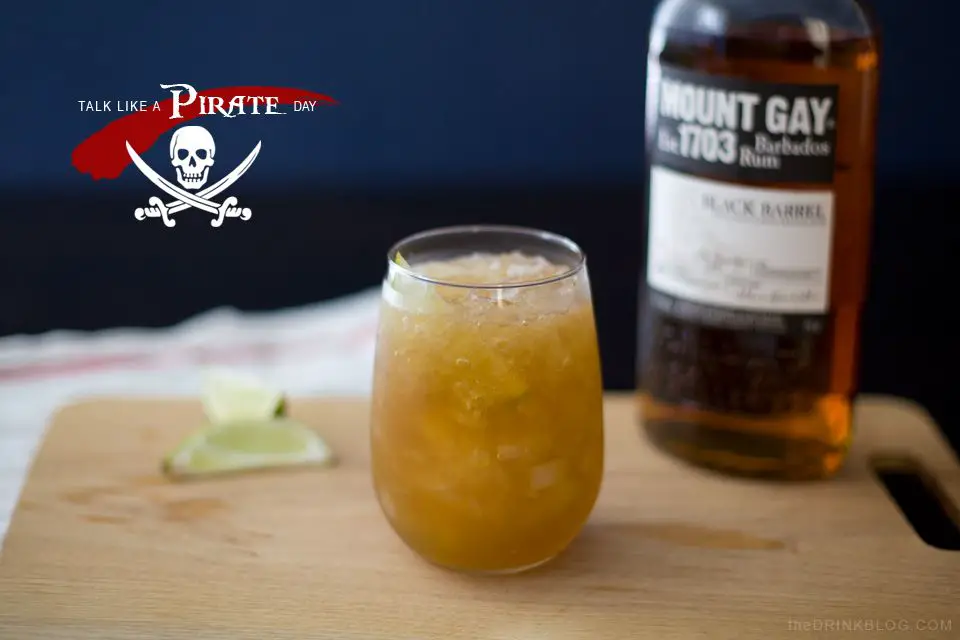What Was Grog Made Of?
Grog is an alcoholic beverage that has historical significance, especially in relation to sailors and navies. The term “grog” originated in the British Royal Navy in the 1700s, referring to a mixture of rum and water served to sailors as part of their daily ration. Admiral Edward Vernon, nicknamed “Old Grog” due to his grogram cloak, introduced the practice of diluting rum with water in order to reduce drunkenness among sailors. After this, the rum mixture itself became known as “grog”. Over time, additional ingredients like lime juice and sugar were sometimes added to grog to improve the taste. The daily ration of grog was an important part of life at sea for British sailors, becoming deeply ingrained in naval culture and tradition. While grog consumption declined in the 20th century, the term is still used today to refer to a variety of rum-based alcoholic drinks.
Origins
Grog first originated in the British Royal Navy in the 17th century. In 1655, British Vice Admiral William Penn captured the island of Jamaica, which became an important base for the Royal Navy in the Caribbean. With easy access to rum produced in Jamaica, alcoholic beverages became very popular among sailors in the British fleet.
The term “grog” itself traces back to British Admiral Edward Vernon, who was nicknamed “Old Grog” in the 1740s because he wore grogram cloaks. In 1740, Vernon ordered that sailors’ rum rations be diluted with water to prevent drunkenness. The early version of diluted rum was named grog in Vernon’s honor (Source: https://en.wikipedia.org/wiki/Grog).
So the origins of grog lie with the British Royal Navy in the Caribbean during the 17th and 18th centuries, as a means of providing watered-down rum rations to sailors. The term grog comes specifically from British Admiral Edward Vernon in the 1740s.
Main Ingredients
The main ingredients used to make traditional grog were rum, water, and lime juice.[1] Rum gave grog its alcoholic kick and was considered an essential component. Water served to dilute the rum’s strength. Lime juice provided tartness that balanced out the sweetness of the rum.
Recipes for grog typically called for an alcoholic spirit like rum as the base. Water was then added in a greater proportion to dilute the strength of the rum so the drink wasn’t overwhelmingly boozy. Lime juice offered acidity to balance the sweetness of rum and give the drink some tartness.
While ingredients like sugar syrup or other flavorings were sometimes included, the core ingredients for making classic grog were rum, water, and lime juice.[2] The key was achieving the right balance between strong rum and diluting water, with a dash of lime to provide some acidity.
Rum
The primary ingredient in traditional grog was rum. Sailors and pirates in the 17th-19th centuries commonly drank rum mixed with water to avoid drinking unsanitary water on ships. Rum originated from distilled sugar cane and was first produced in the Caribbean islands during the 17th century. At the time, rum produced in the Caribbean was known as “kill-devil” due to its harsh taste and potency.
By the 18th century, the Royal Navy began providing rations of rum to sailors to prevent scurvy and for morale. The standard daily ration was around half a pint of rum at a proof of 54.5% alcohol by volume. This rum was often mixed with water or lime juice to create grog. The rum provided nutrients from the molasses and boosted morale among sailors during long voyages away from land. While the Royal Navy eventually abolished the rum ration in 1970, grog remains associated with the maritime history of rum.
Traditional grog recipes often used dark rum or “blackstrap” rum. Blackstrap rum retained more of the molasses during distillation, giving grog a stronger, sweeter flavor. Modern grog may use a variety of rum styles, such as spiced rum or aged rum. However, dark rum remains popular for achieving an authentic, old-fashioned taste.
Overall, rum gave grog its distinct flavor profile and high alcohol content. The history of grog is deeply intertwined with rum’s origins and use in the navies of seafaring nations. While grog included other ingredients like lime and water, rum formed the foundation of the classic grog mixture.

Water
Water was a key ingredient in grog, serving several important purposes.1 First, it diluted the rum, reducing the potency of the alcohol. Given that grog was provided as part of sailors’ rations, adding water prevented the sailors from becoming too inebriated to work. The water also quenched sailors’ thirst, as fresh water could spoil quickly on long voyages. Lastly, the lime juice traditionally added to grog did not fully dissolve in straight rum. The water helped the lime to mix in properly and balance the tart, citrusy flavor. While the rum gave grog its kick, the water allowed it to be safely consumed regularly by sailors undertaking physically demanding labor at sea.
Lime Juice
The lime juice served an important purpose in traditional grog recipes. According to Difford’s Guide (https://www.diffordsguide.com/cocktails/recipe/920/grog), 15ml of freshly squeezed lime juice was a key ingredient. The lime juice helped balance the sweetness of the sugar syrup and added a refreshing tart citrus flavor. It also served as a preservative, helping to prevent spoilage of the grog over long sea voyages.
On pirate ships and in the Royal Navy, fresh limes and lime juice were prized for their vitamin C content. Scurvy was a constant threat for sailors on months-long voyages without access to fresh fruits and vegetables. The vitamin C in lime juice helped keep scurvy at bay. So beyond just flavor, the lime juice served an important health purpose in grog’s origins as a drink rationed out to sailors.
Flavorings
In addition to the main ingredients of rum, water, and lime juice, grog was often flavored with spices, sugar, and other ingredients to improve the taste. Common flavorings added to grog included nutmeg, ginger, brown sugar or molasses, and cinnamon. These warm, sweet spices complemented the rum and helped mask some of its harshness. According to Grog by Cold Ones, spices were frequently blended into grog to give it a more complex, palatable flavor profile. Some recipes also included ingredients like tea, fruit juices, or honey to sweeten the grog. The specific combination of flavorings varied over time and by region, but spices were an essential component in making grog more drinkable and enjoyable.
Alcohol Content
Grog was originally quite strong, with a high alcohol content. The traditional grog ration for sailors in the British Royal Navy consisted of a mixture of 4 parts water to 1 part rum, according to a comment on Reddit (https://www.reddit.com/r/Seaofthieves/comments/15ck9nd/what_is_the_abv_of_grog/). With rum’s alcohol content around 40-80% ABV, this would make traditional grog around 8-16% ABV. The alcohol content helped preserve the water and provided calories, but was still strong enough to impact sailors’ health and behavior when consumed daily.
According to the Wikipedia article on grog (https://en.wikipedia.org/wiki/Grog), the strength of grog was reduced over time, as the negative effects of daily rum rations became apparent. By the late 18th century, the ratio of rum to water had been reduced to 1:8 to 1:12, dropping the ABV to 3-5%. While less potent than traditional grog, this was still a significant amount of daily alcohol intake for sailors at the time.
Modern commercial grog like Grog by Cold Ones (https://grog.shop/) tends to have an alcohol content around 6% ABV, significantly diluted compared to the strength of historical grog rations on ships.
Popularity
Grog was extremely popular among sailors in the Royal Navy. It became part of the official naval ration starting in 1740 when Vice Admiral Edward Vernon ordered that rum rations be diluted with water to prevent drunkenness. Sailors were given a half pint of rum mixed with a quart of water per day. This concoction became known as ‘grog’ after Vernon’s nickname “Old Grog” due to the grogram cloak he wore.
Grog was vital for sailors on long voyages as the rum component helped preserve the ration’s drinkability over several months at sea. The rum was often of poor quality, so mixing it with lime juice helped mask bad flavors. The lime juice also provided vitamin C to help prevent scurvy. While the alcohol content was lowered, grog remained potent enough to provide sailors their daily rum ration.
Beyond the Royal Navy, grog was also popular among merchant sailors and pirates. Different ingredients and recipes were used, but rum diluted with water remained the basis of grog drinks. The popularity spread beyond ships, and by the late 18th century grog was a fashionable drink in British taverns and clubs. Its prevalence among the navy made grog symbolic of sailors’ daily rations and habits.
Decline
Grog fell out of fashion in the mid 19th century as attitudes toward alcohol consumption changed. The temperance movement began advocating for reduced alcohol consumption, and over time grog came to be seen as an excessive drink favored by drunkards and those without self-control. As noted by the U.S. Naval Institute, reformers characterized grog as “an efficient aid to drunkenness and debauchery.”
The British Royal Navy abolished the rum ration, essentially ending grog, in July 1970 according to Proceedings Magazine. The rum ration had been a longstanding naval tradition, but the Admiralty Board decided to discontinue it as social norms shifted. The demise of grog in the navy reflected changing societal views toward alcohol and moderation.
While grog was once considered an acceptable and even vital drink, its high alcohol content ultimately contributed to its decline. As ideals of temperance spread, grog’s popularity rapidly faded. It became associated with excess and overindulgence, hastening its disappearance from mainstream culture.


